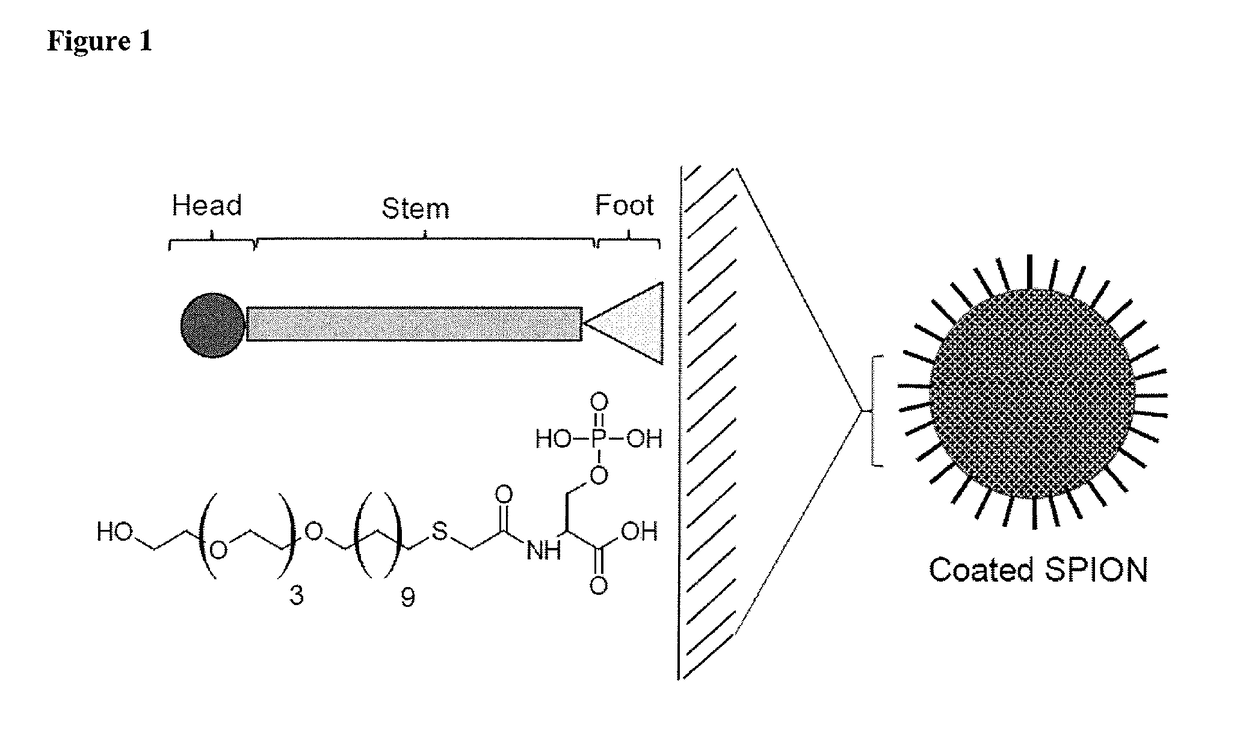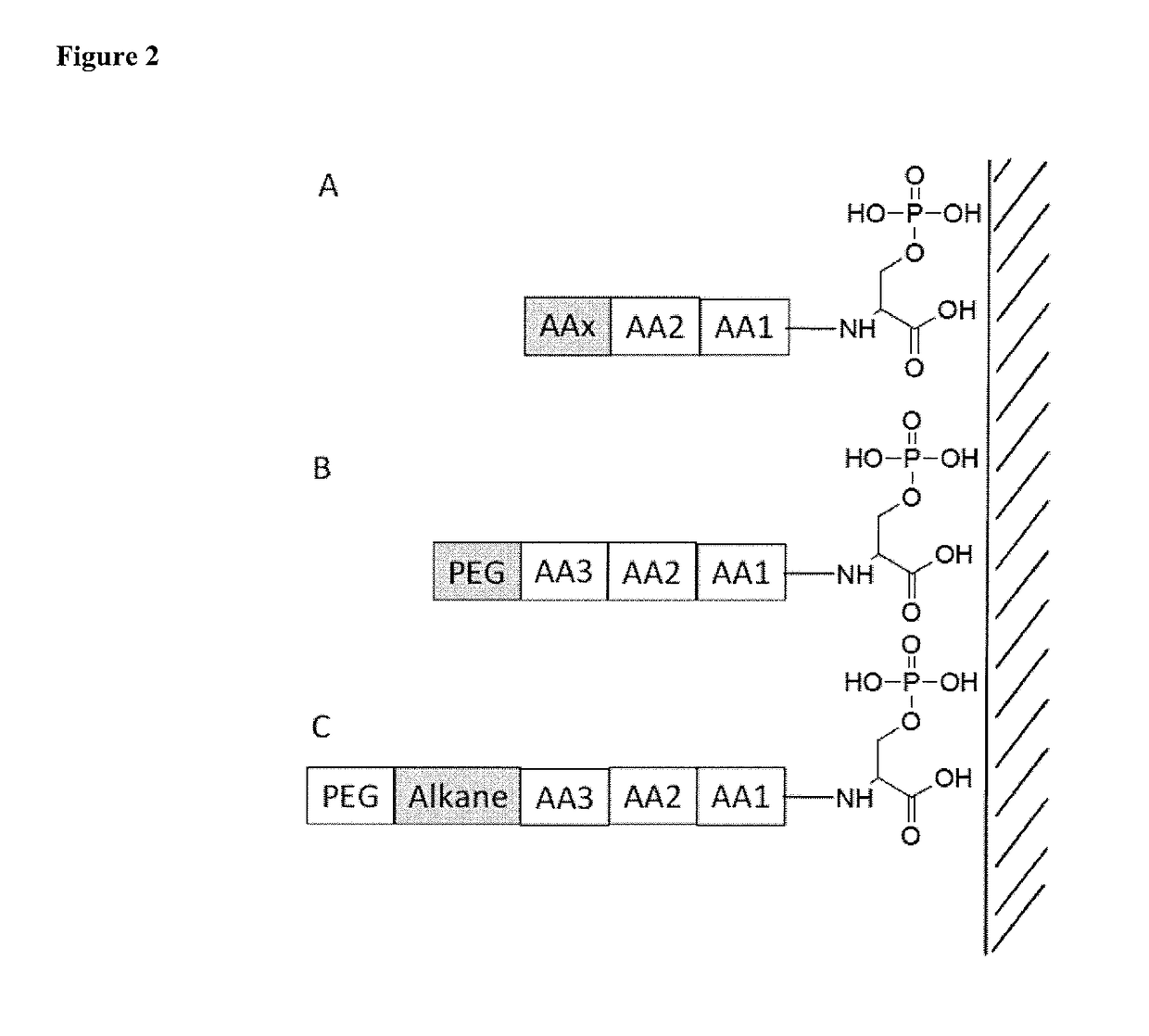Coating for metal nanoparticles
a metal nanoparticle and coating technology, applied in the field of biochemistry, to achieve the effect of good colloidal property in water, high stability, and resistan
- Summary
- Abstract
- Description
- Claims
- Application Information
AI Technical Summary
Benefits of technology
Problems solved by technology
Method used
Image
Examples
example 1
Synthesis of the EG Alkanethiol Phosphoserine Ligand
[0120]The EG alkanethiol phosphoserine ligand for the SPIONs was synthesized using the protocol described below. Where possible, the progress of the reaction was monitored by thin layer chromatography (TLC) and reaction products were characterised by 1H NMR using a Bruker AMX 400 at 400 MHz.
i—Synthesis of Benzyl iodoacetate (1)
[0121]Sodium iodide (5 mmol) was added to a solution of benzyl bromoacetate (1 mmol) in acetone (5 mL / mmol) at room temperature and stirred for 2 h. The reaction mixture was diluted with diethyl ether and stirred at room temperature for 20 min before being filtered through celite and concentrated in vacuo. The residue was suspended in diethyl ether and filtered through celite to give the product as an orange oil, which was used without further purification.
1H NMR (400 MHz, CDCl3): 7.39-7.26 (5H, m, 5 x ArH), 5.18 (2H, s, CH2Ph), 3.82 (2H, s, CH2I).
ii—Synthesis of Benzyl-1-hydroxy-3,6,9,12-tetraoxa-24-thiahexa...
example 2
Ligand-exchange Mediated Transfer of SPIONs to Aqueous Solutions
[0131]Upon receipt, the SPIONs were coated in oleic acid ligands and were soluble in toluene (FIG. 3A). For these SPIONs to be suitable for biological applications, they first have to undergo ligand exchange to render them soluble in aqueous solutions (FIG. 3B).
[0132]The protocol requires THF to act as an intermediate solvent for the ligand-exchange reaction to take place, multiple loadings of the incoming ligand and a ligand-exchange step using Sephadex G25 chromatography equilibrated with the incoming ligand. No chloroform washing as performed during the SPION ligand-exchange protocol, as it was found that performing washes of the SPIONs using toluene before any EG alkanethiol phosphoserine ligand was added was sufficient to remove enough of the outgoing ligand to make efficient ligand exchange possible without destabilising the nanoparticles. When the EG alkanethiol phosphoserine ligand was added, it was added in 150...
example 3
Novel Ligands
[0137]A novel library of peptides and ligands was designed to prepare peptide coated of iron oxide nanoparticles.
TABLE 1Peptides and ligands library.NamesStructuresLigand L1(HO)2-PO-S-C11-EG3-OHLigand L2(HO)2-PO-S-C11-EG6-OHLigand L3(HO)2-PO-S-(CH2)16-OHPeptide S1H-Ser(PO3H2)-NH-PEG4-olPeptide S3PO3H2-O-CH2-CO-NH-PEG-olPeptide S5PO3H2-O-CH2-CO-Gly-NH-PEG4-OHPeptide S6PO3H2-O-CH2-CO-Gly-NH-PEG4-olPeptide S7PO3H2-O-CH2-CO-Ser(PO3H2)-NH-PEG4-OHPeptide S8PO3H2-O-CH2-CO-Ser(PO3H2)-NH-PEG4-olPeptide S9H-Ser(PO3H2)-Ser-Ser-Ser-Ser-olPeptide S11H-Ser(PO3H2)-Phe-Phe-Phe-Thr-olPeptide S13H-Ser(PO3H2)-Val-Val-Val-Thr-olPeptide S14PO3H2-O-CH2-CO-Ser(PO3H2)-Val-Val-Val-Thr-olPeptide S15H-Ser(PO3H2)-C11-PEG4-olPeptide S16PO3H2-O-CH2-CO-Ser(PO3H2)-C11-PEG4-olPeptide S18PO3H2-O-CH2-CO-Tyr(PO3H2)-Val-Val-Val-Thr-ol
[0138]The library currently consists of 16 peptides and ligands. The rationale for the design of the peptides is presented in the Table 2. All peptides and ligands present one...
PUM
| Property | Measurement | Unit |
|---|---|---|
| pH | aaaaa | aaaaa |
| pH | aaaaa | aaaaa |
| pH | aaaaa | aaaaa |
Abstract
Description
Claims
Application Information
 Login to View More
Login to View More - R&D
- Intellectual Property
- Life Sciences
- Materials
- Tech Scout
- Unparalleled Data Quality
- Higher Quality Content
- 60% Fewer Hallucinations
Browse by: Latest US Patents, China's latest patents, Technical Efficacy Thesaurus, Application Domain, Technology Topic, Popular Technical Reports.
© 2025 PatSnap. All rights reserved.Legal|Privacy policy|Modern Slavery Act Transparency Statement|Sitemap|About US| Contact US: help@patsnap.com



